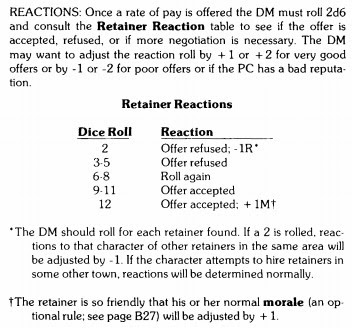Aside from increasing the results from three to five entries, Holmes adds a couple of other things. First, his results suggest that the characters are making an "offer" to creatures and that this table should be used when adjudicating such an interaction. Second, he makes a stronger connection to the importance of Charisma (something OD&D alludes to elliptically in Volume I. Moldvay, in his edition of the Basic Rules goes a step further, dividing the reaction table into two, one for dealing with retainers and one for monsters. Here's his table for retainers:
What Moldvay seems to have done is picked up on Holmes's references to "offers" and decided to create a distinct table, one solely devoted to a potential retainer's reaction to negotiations about rates of pay. Earlier in the book, it's stated that Charisma bonuses and penalties apply to this roll, in addition to the specific modifiers mentioned here. Later, there's another table to govern monster reactions.
This table has the same range of results as Holmes's expanded table and even uses some of the same verbiage, but provides the referee an out by stating that he "can always choose the monster's reactions to fit the dungeon." I find "to fit the dungeon" an interesting turn of phrase and wonder a bit about its precise meaning. I imagine he simply meant that the referee should not use the table in circumstances where it an enemy's reaction should be obvious, such as, say, guards in a prison or fanatical cultists in a hidden shrine. Further, it's likely just another example of the tendency of old school D&D to prioritize the referee's judgment over any rule as written. AD&D has a very similar system to this one, except that it uses percentile dice instead of 2d6.As is so often the case these days, I like Moldvay's approach; they're the ones I've more or less adopted, even in games (like Empire of the Petal Throne) that have their own reaction systems. If I had to guess why many referees don't make use of these tables – aside from forgetfulness – it's an unwillingness to relinquish control of events in their games to dice rolls. Perhaps I'm wrong on this score. Speaking only for myself, I am often lazy and in need of inspiration and random reaction tables regularly help me overcome both these deficiencies. They're not a panacea and shouldn't be used in every instance, but I like to lean into randomness in my games and see where it leads me. I recommend it.






I love rolling reaction and then having to come me up with a quick reason some obviously friendly person hates the party or an assumed enemy is friendly. Such a great spur for invention and DM surprise.
ReplyDeleteInstead of reaction, I like rolling on the "socialite challenges" in Silent Legions to roll up NPCs that are almost like li'l puzzles. Why aren't they giving the characters what they want? It's b/c [rolled up reason].
ReplyDeleteFor monsters OTOH I rarely need to roll b/c the player characters will usually be the hostile party :D
The table in Holmes is adapted from the other reaction table in OD&D, in Vol 1, which has 5 entries instead of 3.
ReplyDeleteRight you are! Thanks for pointing that out.
DeleteThe Mentzer basic set has it built into the encounter steps.
ReplyDelete"1. Number Appearing: determined by the DM (page 22).
2. Surprise: DM rolls Id6 for each side (monsters and party) (page 58 of the Player's Manual).
3. Reactions: DM rolls 2d6 for the monsters' first reactions (page 22).
4. Results: If —
a. both sides talk, continue reaction rolls, negotiation, etc. as needed.
b. one side runs away, the DM handles Evasion and Pursuit (page 16).
c. one side attacks, continue with ORDER OF EVENTS IN COMBAT."
Page 22 has:
"Monsters may have nearly any reaction to the appearance of a party, unless the monster description says otherwise."
As this text was written specifically to teach it to those who were new to the hobby, I wonder if they intent in earlier editions was for it to be more common.
Well Observed. And speaking of Mentzer, BECMI actually makes the table a bit more complex.
DeleteI love to randomize basically everything, which is why I have used Reaction and Morale since the beginning (I started playing with Moldvay in 81), and love random encounters and sandbox hex-crawl style adventures (I also cut my teeth as a DM on the Wilderlands, with all the classic Judges Guild tables). I prefer to let the story emerge from the random nature of reality, than try to shoehorn my players and world into a pre-set story.
ReplyDeleteI've actually had whole series of major events develop using the Dungeon Dressing tables in the DMG (Appendix I). My favorite was when the party found a magic-user's alchemist lab and I randomly determined it was 90% intact, so rolled a bunch of stuff from the magic-user furnishings table and they realized it was a major treasure trove... if only they could get all that very valuable, very fragile stuff out of the dungeon! Took a lot of planning and work... and a lot of role-play. Not to mention finding the right buyer, who became a patron for the party.
Then again, sometimes random dungeon or wilderness dressing can end up being a problem, as in the classic Knights of the Dinner Table comic about the rock or the cow... but even then, fun can be had.